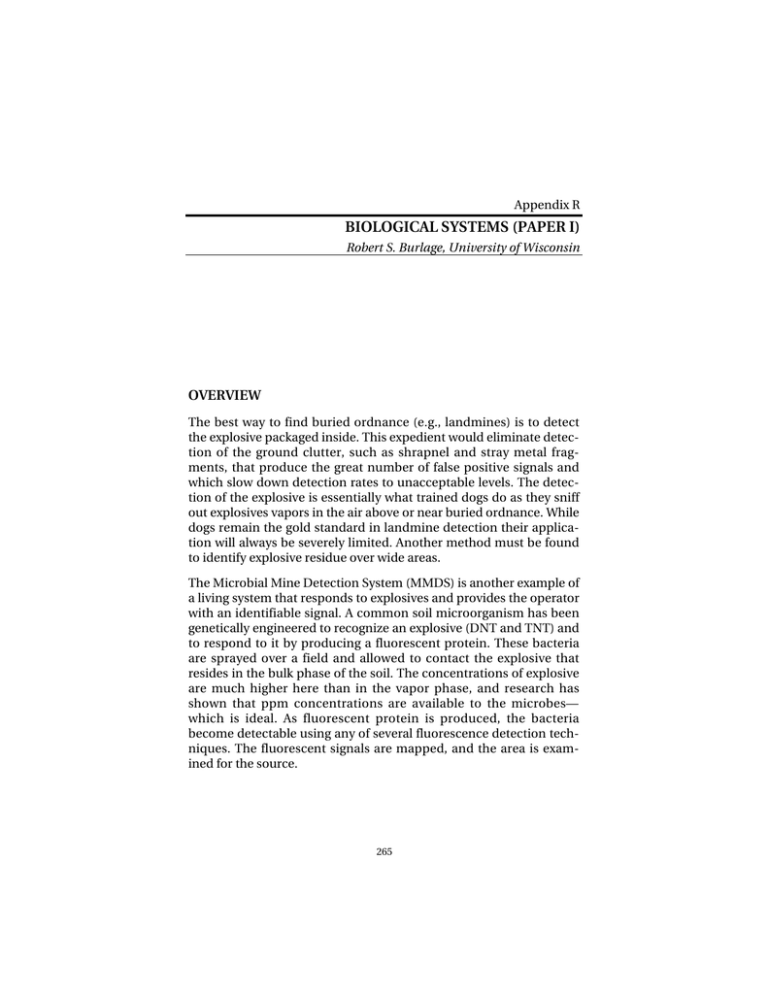BIOLOGICAL SYSTEMS (PAPER I) OVERVIEW
advertisement

Appendix R BIOLOGICAL SYSTEMS (PAPER I) Robert S. Burlage, University of Wisconsin OVERVIEW The best way to find buried ordnance (e.g., landmines) is to detect the explosive packaged inside. This expedient would eliminate detection of the ground clutter, such as shrapnel and stray metal fragments, that produce the great number of false positive signals and which slow down detection rates to unacceptable levels. The detection of the explosive is essentially what trained dogs do as they sniff out explosives vapors in the air above or near buried ordnance. While dogs remain the gold standard in landmine detection their application will always be severely limited. Another method must be found to identify explosive residue over wide areas. The Microbial Mine Detection System (MMDS) is another example of a living system that responds to explosives and provides the operator with an identifiable signal. A common soil microorganism has been genetically engineered to recognize an explosive (DNT and TNT) and to respond to it by producing a fluorescent protein. These bacteria are sprayed over a field and allowed to contact the explosive that resides in the bulk phase of the soil. The concentrations of explosive are much higher here than in the vapor phase, and research has shown that ppm concentrations are available to the microbes— which is ideal. As fluorescent protein is produced, the bacteria become detectable using any of several fluorescence detection techniques. The fluorescent signals are mapped, and the area is examined for the source. 265 266 Alternatives for Landmine Detection Although this technique has been demonstrated in the field, it has been starved for funding and never developed in the appropriate manner. Significant problems remain but should be solvable. Thus it remains a largely untested and theoretical approach to broad area detection. The technique itself has been patented [1]. STATE OF DEVELOPMENT As mentioned above, this technology should be considered basic laboratory research. The technology involving recombinant bacterial strains has been performed by the principal investigator for many years. Detection of fluorescence has been practiced far longer. The application of such bacterial strains in an environmental setting and the rapid detection of fluorescent signals over large areas are relatively new concepts, and much work remains before they can be considered optimized. However, the technology has been field tested. This test was somewhat of a rush to the field, and the principal investigator wished for more time to adequately test the technique, but one must take opportunities as they are presented. The results of this test are available [2]. Important details of the technique and the field test have also been reported [3]. During this test the MMDS technique detected all five of five targets within a quarter-acre site, within a distance of 1 m. Targets ranged in size from 4 oz to 10 lb of explosive. There were two false positive signals, defined as being outside the 1m radius from a target. However, it was hypothesized that these signals were not false at all, but rather they were small fragments of TNT that were physically transported away from the target by water flow or animal activity. In the absence of a definitive assay, this hypothesis remains unproved but highly likely. The test required several hours for detection, although it should be emphasized that this was the first field test and much time was taken in deciphering unique signals. As more is known about the capabilities in the field, this analysis time will greatly decrease. Our goal is to cover a 10-m-wide strip of ground at walking pace (3 miles per hour) or slightly faster. The MMDS technique has been tested in two other locales. The first was at a U.S. Air Force base in the desert and the other at a closed ammunition plant in an eastern deciduous forest. Both tests were conducted under suboptimal conditions. In the first test, a charge of Appendix R 267 TNT was detonated and the area downwind of the site was examined for dispersed fragments. In the second test, the bacteria were sprayed over an area known from historical records to be contaminated with a number of different explosives. Positive signals were found in each case, although the tests did not utilize discrete point sources, and therefore a detection rate cannot be produced. Reports on these two releases are available from the principal investigator. It is clear from these few tests that the system should function under a certain set of parameters. Once applied, the bacteria require about four to six hours before they maximize their output of fluorescent protein (and thus become optimally detectable). About 106 bacteria per square centimeter are preferred. The signal is then stable for the next 24 hours, although the bacteria die off exponentially over the next several days. Thus the objective in mine clearance is to spray relatively large areas (hundreds of acres) at a time; the slowness of the incubation period is balanced by the large area covered. The defining factor in speed then becomes the fluorescence detection step. STRENGTHS This technique has several unique attributes. Bacteria can be grown easily and without great expense: They need only a solution of sugar and some inexpensive chemicals. The cost of the technique is outlined below but can be considered very affordable—even for developing nations. In addition, the technique costs the least when very large areas are examined. This contrasts with many other techniques that have a set cost per area covered. The system is dependent on a bacterial regulatory protein that recognizes the shape of the explosive chemical. Only structurally similar molecules have this same “lock and key” effect, and the mere presence of nitrogenous sources in the soil is insufficient to trigger the effect. It is likely that other bacterial strains can be produced which are responsive to other explosives, such as RDX and HMX. However, these have not yet been produced. This is a matter of scientific inquiry and requires funding, but there is no good reason why a suitable strain cannot be produced. The various strains can then be mixed together in a cocktail of explosive-sensitive bacteria. 268 Alternatives for Landmine Detection Many present and proposed techniques for mine clearance are adversely affected by the presence of vegetation. The MMDS technique is actually improved by the presence of vegetation, which appears to conduct the explosives and magnify the signal. MMDS may be the only suitable system for many areas of the world where removal of vegetation would have adverse environmental consequences. Because the technique detects the presence of the explosive chemicals, and not the ordnance package, it will not be affected by stray bits of metal. While it may find trace amounts of chemical residue from recent explosions, it will probably find only those signals that result from a continuous source of explosive at low concentration, such as a buried landmine. It will also find a raw explosive that is buried or find discarded ammunition that has been forgotten. It has been suggested that this system may work best as one of several complementary techniques for the same field. The MMDS system is envisioned as a fully portable system. The major weight consideration is the wet weight of the bacteria. At present, we transport the bacteria as a thick paste, which stays fresh for a couple of days. However, we have some experience with freezedrying bacteria to remove the water weight and increase their longevity. It is also possible to grow the bacteria on site using a portable fermentor. This would make the technique portable to any area of the world. Based on the final configuration of the fluorescence detection system, the initial capital cost might be a little high. However, this is a onetime charge (not considering spare parts) and the remainder of the system then becomes very affordable. There is also little cleanup afterward, as the bacteria die off rather quickly and actually serve as a fertilizer for the soil. WEAKNESSES There are still major weaknesses of the system that must be addressed, as befits a basic research project. Our field trials have suggested many of the problems. For example, we still need to know much more about the partitioning of explosive chemicals between soil (clay, silt, sand, organic) and the bulk phase because only the bulk phase material is ultimately detectable. We have also had substantial problems with dispersal of the bacteria over dry ground, Appendix R 269 where the bacteria will be quickly absorbed by the soil and the signal lost to detection. We have experimented with encapsulation techniques to overcome this difficulty, but there is a substantial tradeoff in effectiveness. Other techniques are possible. To work effectively, the bacteria must physically contact the explosive. In addition, the overall soil conditions must not be too deleterious, considering that a living system must be used. Therefore, a snowy field would be too cold for application and would block the bacteria from the explosive in the soil. Recent rain would change the location of the signal, as we have seen in the field. Of course, this limitation is common to other methods that detect the explosive itself. It has been suggested that the use of a microorganism for mine clearance would constitute the use of a biological weapon, as defined by international weapon control treaties. An objective reading of these treaties indicates that the use of MMDS in a battlefield scenario would undoubtedly violate the treaty, although use in humanitarian demining, even broadly defined, would not violate the treaties at all. It has also been suggested that this technique would not receive widespread approval because it utilizes genetically engineered microorganisms. This has not proved to be the case. We work closely with the U.S. Environmental Protection Agency on the release of recombinant bacteria and only with its approval. All three field releases have been performed without incident. Other countries have expressed interest in the technology even after the components of the system are explained to them. There seems to be no great obstacle due to the nature of the bacteria. Finally, the fluorescence detection system has, in the past, proved unable to clearly identify a signal in many instances. To a great degree, this is a learning activity as we decide which fluorescent intensity is background and which is above the threshold for a positive signal. Clearly, alterations in the detection system and possibly in the fluorescence protein used will have to be considered. Because the ultimate goal is the production of an airborne system that can cover hundreds of acres per day, the detection system will have to meet size and weight requirements. 270 Alternatives for Landmine Detection PROBABLE COST OF A FUNCTIONAL SYSTEM It has been estimated that most of the difficult questions regarding the viability of this system could be answered in about two years of research at a total cost of $650,000. This research would address critical questions about the stability of the genetic construction, partitioning of explosive residue in various soil types, the role of vegetation in uptake and magnification of the signal, and reliable dispersal methods that allow the system to be used in many soil types. In conjunction with these tasks, the application of commercial fluorescence detection systems should be evaluated to determine whether “off the shelf” technology could be successfully employed in an airborne system. Final costs are quite speculative at such an early phase of the project. Major capital equipment costs will be required for an on-site fermentor (if needed) and for the fluorescence detection system. I estimate these costs to be in the $250,000–300,000 range. Subcontracting the fermentation process is a better option and will save significant sums. In addition, the airborne platform (probably a helicopter) will also need a subcontract. Dispersal of the bacteria is relatively inexpensive—mostly unskilled labor. The goal is to cover an acre of ground in small patches for $10–40, while the price would drop below $10 per acre for larger areas (hundreds of acres). POTENTIAL IN THE SHORT TERM As noted above, a two-year basic research program would answer most, if not all, of the questions that funding agencies have raised after our earlier tests. This would be a team approach because research is needed in several areas: microbiology, botany, engineering, fluidics, etc. After this time it should be ready for defined-field testing or for real-world conditions. I would like to analyze an actual minefield to map the signals and then have the field cleared using conventional technologies to determine our efficacy as well as our nearness to target and any confounding influences. While definedfield tests can do this to some extent, an actual minefield to gather data is best. Because our technique is nondestructive of the field, the mine clearers will not be influenced by our results. I am particularly interested in any mines that we may miss. Will they contain a novel Appendix R 271 explosive? Are they associated with a certain soil type (such as high clay content)? Were they placed in the ground recently? In our first test, we used targets that had been buried for three months—but real-world conditions may not be similar. We have contacted many interested individuals in other countries with access to minefields. They are reticent about funding the project because too many unknowns remain. We would like to approach them again with an improved and more predictable system. With a reliable system, a best-case scenario of 100-percent detection with essentially no false positive signals can be predicted. This is a bold prediction, but it is based on the specificity of the explosive for the bacterial regulatory protein, the sensitivity of the system compared with known leakage concentrations, and the demonstrated sensitivity of fluorescence detection systems (which are assumed to improve even more). The typical sites for these predictions would be old (1–20 years) minefields, such as those found in Bosnia, many parts of Africa, the Falkland Islands, and many parts of Southeast Asia. Efficiency of the system may suffer in areas where the environment is more hostile, such as in desert regions (e.g., the Middle East). However, encapsulation techniques for the bacteria and judicious timing to avoid the extreme temperatures may dramatically improve the technique. MMDS is not predicted to work well in those areas with standing water, consistently low or high temperatures, or snowcovered soil. REFERENCES 1. R. S. Burlage, K. Everman, and D. Patek, Method for Detection of Buried Explosives Using a Biosensor, U.S. Patent No. 5,972,638, 1999. 2. W. Schaefer, Test Report for the Microbial Mine Detection System (MMDS), DSWA IACRO HD1102-8-1490-097, 1998. 3. R. Fischer, R. Burlage, J. DiBenedetto, and M. Maston, “UXO and Mine Detection Using Laser Induced Fluorescence Imagery and Genetically Engineered Microbes,” Army AL&T, July–August 2000, pp. 10–12.



